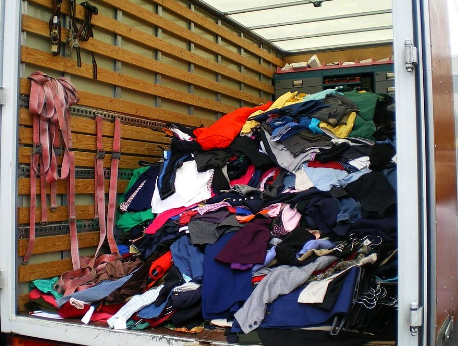OPINION: Slow down on fast fashion

Photo courtesy of JenWaller (CC BY-NC-SA 2.0)
Often clothes bought from micro trends end up in the garbage. We must do our part to purchase clothing mindfully.
Tiktok feeds are flooded with influencers constantly posting their favorite products. They come home to more PR boxes than imaginable, and open more makeup then they could possibly use. Their followers, wanting to keep up with the trends, flock to stores to buy Gen Z’s “it girl” Alix Earle’s everyday white eyeliner or Remi Bader’s favorite Revolve dress.
It isn’t these influencers’ faults, but our society has become obsessed with consumption. New clothes become trendy every day, and a couple weeks later they are thrown to the waste side and deemed unacceptable to wear. The problem lies in the production and lack of longevity of these quick turn-around trends. These so-called micro trends create an ethical fashion dilemma. Is a $5 shirt that follows the latest Tik Tok trend really worth it?
Some brands are infamous for their participation in fast fashion, like Shein, an online company that adds thousands of new products to their site every day. But, even well-known beloved brands, such as H&M, Zara and Forever 21 participate in fast fashion. In order to keep up with their profits and the enormous yet fleeting demand for certain trends, these companies create cheap, trendy clothing that go into the market as fast as possible, usually with no regard for the ethicality of their choices.
The problems with fast fashion are complicated. For one, these companies are usually hiring garment workers who work in dangerous environments for long hours and low wages. In order to sell the garments for so cheap, the cost of labor must be even cheaper.
Fast fashion also has consequences for our planet. It continues to contribute to the “throw-away” culture that has been continuing to grow. These clothes are worn once or twice and thrown out, filling up landfills across the globe, and contributing to the worsening of the state of our planet. According to Good on You, a website and app that rates brands on their sustainability, the fashion industry is one of the largest polluters of clean water globally because of its use of cheap, toxic textile dyes. These dyes are more likely to be used at companies looking to have a quick turnaround with their goods and make as much profit on a cheaply sold good as possible.
It isn’t feasible to stop shopping at all of our usual stores. Finding a completely sustainable and affordable brand is close to impossible to do, and we shouldn’t be asked to abandon the clothes we normally buy. But, we can all do our part to be slightly more sustainable in our fashion consumption by trying not to buy clothing that plays into micro-trends and thinking about the longevity of a piece before deciding to purchase it.
These large corporations who continue to underpay their workers and contribute to climate change are the ones who are responsible. As the consumers of these corporations, we must keep them accountable and educate ourselves on the practices of the brands we buy from.
Photo Credit: “Pile o’ clothes” by Jen Waller is licensed under (CC BY-NC-SA 2.0).







![[VIDEO] School Spotlight for Spring 2025](https://thewessexwire.com/wp-content/uploads/2020/03/westessex-475x356.jpg)
![[VIDEO] Varsity Media Day: Winter 2025](https://thewessexwire.com/wp-content/uploads/2025/02/vmd-25winter-600x450.jpg)

